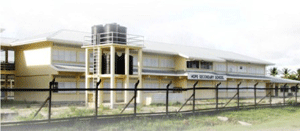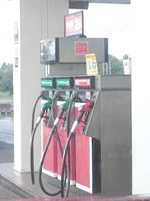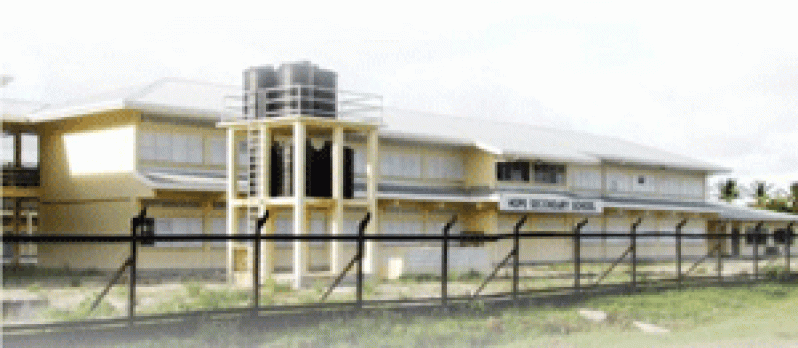DRAINAGE and irrigation structures are imperatives for agriculture, particularly for a country like Guyana, and especially at a time when the country has become more vulnerable to the challenges of the weather due to climate change.
 Nevertheless, the task is not only to maintain these structures and associated machinery and equipment, but to modernise and expand them, including construction of new dams and canals, new sluices and installation of more pumps.
Nevertheless, the task is not only to maintain these structures and associated machinery and equipment, but to modernise and expand them, including construction of new dams and canals, new sluices and installation of more pumps.
The National Drainage and Irrigation Authority (NDIA) functions as the main agency dealing with all public matters pertaining to management, improvement, extension and provision of drainage, irrigation and flood control infrastructure and services in declared areas of the country. It also provides support and assistance to other public institutions dealing with connected activities. The NDIA is mandated to develop mechanisms for improved water use with financial sustainability, equity and efficiency as guiding principles.
In meeting its mandate, the NDIA had an active year in 2012, with some notable achievements which focused on improving and upgrading drainage and irrigation services countywide, thereby enhancing the competitiveness of the various sectors and improving productivity.
Adapting to Climate Change–Hope canal
Through the work of the NDIA, the Ministry of Agriculture is ensuring that agricultural land is better protected against adverse weather related events. The much anticipated construction of the East Demerara Water Conservancy’s (EDWC’s) Northern Relief Channel at Hope/Dochfour, East Coast Demerara, continued, prompting a wave of support from many farming communities in Mahaica, Mahaicony and East Coast Demerara communities. The excavation of the channel was approximately 83% complete at the end of 2012.
Works on the Public Road Bridge, outfall structure and the head regulator continued and the completion of the channel and commissioning will be done in 2013.
 Building capacity
Building capacity
Over the years, and 2012 in particular, the NDIA has been building its capacity, resulting in a significant number of pieces of equipment being acquired, inclusive of mobile and fixed pumps, long reach excavators, bulldozers and other machinery.
Under the Indian line of credit, 14 pumping units would be acquired to be deployed along the coastland, while the Japanese Government has donated eight excavators and two pontoons for works to be undertaken in the EDWC.
Rehabilitation and construction of sluices
The NDIA has adopted a policy of constructing and rehabilitating sluices that are found to be functional through suitable foreshore conditions along the coast and riverine areas, aimed at upgrading and expanding the drainage system. These works allow for expanded acreage of agricultural activities and to better cope with extreme rainfall events associated with climate change.
All improved and rehabilitated sluices are now serving areas to withstand in excess of 2.5” of rainfall in 24 hours as compared to 1.5” in 24 hours before.
Major rehabilitation of the Buxton and Garden of Eden sluices in Region 4 commenced in 2012, while sluices were constructed at Waterloo, Noitegadact, and Wakenaam in Region 3, Grove/Diamond in Region 4, Profitt, Abary (60%), Retrieve and Cottage, Mahaicony in Region 5 and at Mara and Bengal (70%), Region 6. At Bengal, a pump station is also being constructed.
Pump stations
Pumping capacity is critical for Guyana, and in this respect, 126 pumps are operational throughout the country. The NDIA operates 48 of these pumps.
A major effort was made in 2012 to improve the pumping capacity in the country with new mobile and fixed site pumps. Such is evident in the procurement of six new mobile pumps and eight new fixed-site pumps which are due to arrive in January and March 2013.
Other successes include the commissioning of the Greenfield pump station, tenders for a pump station at Pineground, Mahaicony were sent out, and the study and consultations for the design for construction of new drainage outlet sluice and pump station for Canal No.2 Polder.
D&I work in vulnerable communities
Due to increased rainfall in 2012, the NDIA continued its efforts to reduce vulnerability of flood-prone areas.
In the Pomeroon, Region 2, more than $40M was spent on empoldering farmlands, raising embankments and excavating drainage channels, much to the satisfaction of farmers and residents.
Meanwhile, in Mahaicony, Region 5, the NDIA embarked on construction of an internal embankment to protect farmers and residents from rising water levels during the rainy season. Additionally, much work has been done on the right bank of the Mahaicony River, including heightening of embankments and empoldering of farmlands.
Rehabilitation of D&I infrastructure
The NDIA’s implementation of an aggressive plan for upgrading and rehabilitation of drainage and irrigation infrastructure to ensure optimum capacity continued in 2012.
Rehabilitation of drainage structures were undertaken in Region 2 in the Pomeroon; embankment structures were built at Palmyra, Ridge and Bushlot, Wakenaam, Caledonia, Eastern and Western Hogg Island in Region 3; a drainage culvert at Garden of Eden, Coverden, Region 4, was completed; in Region 6, at Moleson Creek and at Lonsdale, and in Region 10 control structures were constructed in West Watooka, a concrete drain system at Victory Valley, and a drainage system at Canvas City were completed.
Construction of timber sheet piles was undertaken at Capoey, Region 2, while revetment works were undertaken at Beehive, Region 4. Additionally, under the Agriculture Support Services Project (ASSP) ,sluices were also constructed at Cane Grove and Craig Milne/Victoria, Region 4.
Community Drainage and Irrigation Project
The NDIA, through its Community Drainage and Irrigation Project (CDIP) has also been supporting vulnerable residential areas by clearing critical drains and canals. A new work plan under the project was put in place which significantly boosted operations.
About 900 miles of canals and drains were cleared by CDIP workers within this period, while a significant number of critical canals were also cleared around Georgetown.
Outfalls
The NDIA, using its dredging equipment, has been able to clear critical outfalls along the coastline to allow for gravity drainage at low tide, especially when drainage canals are at exceeding freeboard levels.
Main outfall channels were dredged at Lima, Perth, Andrews, Anna Regina, Three Friends, La Union, Somerset and Berks in Region 2; Canals Polder, Windsor Forest, La Jalousie in Region 3; Greenfield, Hope, Belfield, Victoria, Golden Grove, Enmore/Foulis and Buxton in Region 4; and Sea Well, Whim, Letter Kenny, Liverpool, Kildonan, Eversham, Joppa and Lesbeholden in Region 6. Excavation of outfall channels along the Demerara River was also undertaken.
Canal maintenance
During 2012, over 900 miles of drains and canals were maintained in Regions 2, 3,4,5,6 and 10 by the NDIA. The Water Users Association also assisted with the maintenance of the secondary drainage and irrigation systems in key farming areas.
Other Works executed in 2012
Some of the other works carried out in 2012 include heightening of two areas, to the 67.00GD point, along the EDWC dam, to avoid overtopping. Construction of Abary/Mahaicony main irrigation canal which is on the watershed between the two rivers was also started. This will guarantee irrigation and increases in the acreage of rice planted. The proposed canal is 12 miles and will be executed in phases. Thus far, 3.5 miles was completed in 2012.
To maximise drainage and irrigation, 88 miles of channels was rehabilitated in 2012. And as a result, farmers have benefited from improved drainage and irrigation which resulted in more lands cultivated with rice. More than 100 farmers benefited from 162 miles of secondary drains and canals that were rehabilitated.
The Abary flood embankment was rehabilitated for a distance of 3.5 miles, while six heavy-duty timber bridges were constructed. Farmers will save time to access their farms and experience less wear and tear of their machinery and equipment.
Intense rainfall over the years has resulted in inundation to some low lying communities, such as Experiment, Waterloo, Cotton Tree, No. 28 and Lovely Lass. The need for an additional outlet was recognised and the sluice at No. 12 was rehabilitated bringing the total number of sea sluices in the West Berbice area to four. (GINA)



.jpg)








